About "nano"
For the third year in a row already at the beginning of November, the International Nanotechnology Forum , Rusnanotech2010, has been held . As part of this event, Intel and RUSNANO summed up the results of the third All-Russian competition of projects in the field of high-performance computing.
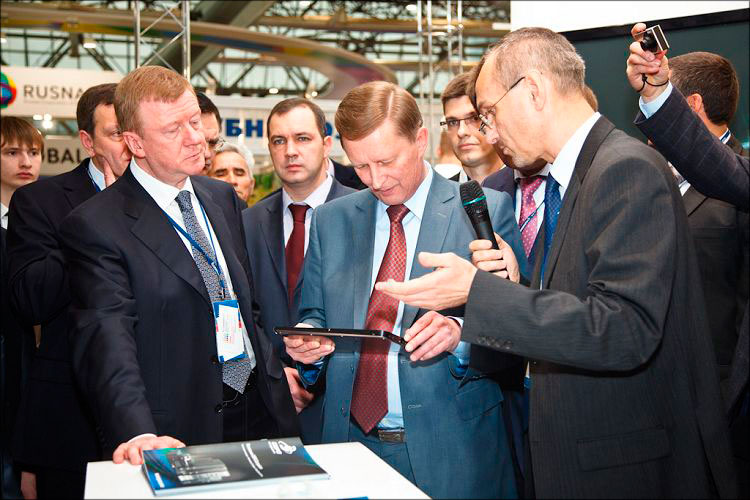
Anatoly Chubais lobbies the law so that 1% of each sold wrench size less than 24 is listed on nanotechnology
Some interesting under the cut.
The purpose of this competition is to identify the best work in using the capabilities of supercomputers, popularize supercomputers and clusters, as well as demonstrate the possibility of practical application of high-performance computing for the needs of various branches of science and industry; and, of course, the support of young scientists seeking to realize themselves through innovation. Under the motto “The Impossible became possible ”, 82 as many works were submitted (which is 2 times more than last year) for the competition, the total prize fund of which amounted to almost one million rubles. The concentration of inquiring minds turned out to be quite expected, the regional variation of the participants is as follows:
')

Participants presented projects on the use of HPC in biology, bioinformatics, geology, three-dimensional gas and hydrodynamics, which, in general, correspond to world trends. Interesting methodological and infrastructural developments related to the creation of tools for the development of various applications were also proposed. The names of most of the projects for me seem somewhat mysterious, despite my technical education) But even more surprised that almost half of the winning works belonged to ... girls! I will not beat around the bush, but will name the winners:
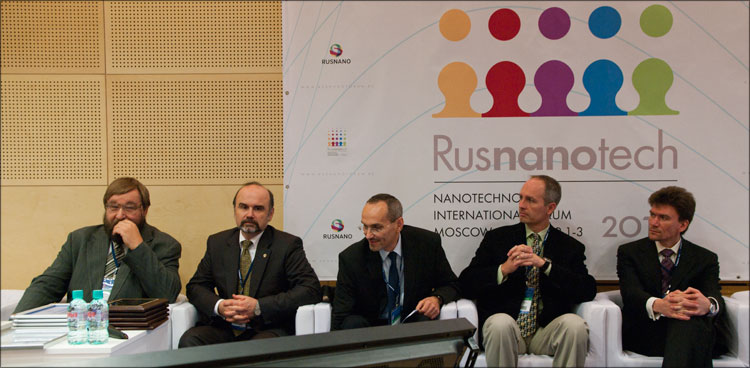
First place : "Numerical simulation of the interaction of seismic waves with cavernous fractured reservoirs in three-dimensional non-uniform environments of realistic structure"
Applicant : Ph.D. Reshetova Galina V. from the Institute of Computational Mathematics and Mathematical Geophysics of the SB RAS
Prize : 250000 rubles
Second place : "Development of energy-efficient body armor on the basis of gradient energy using gradient structures"
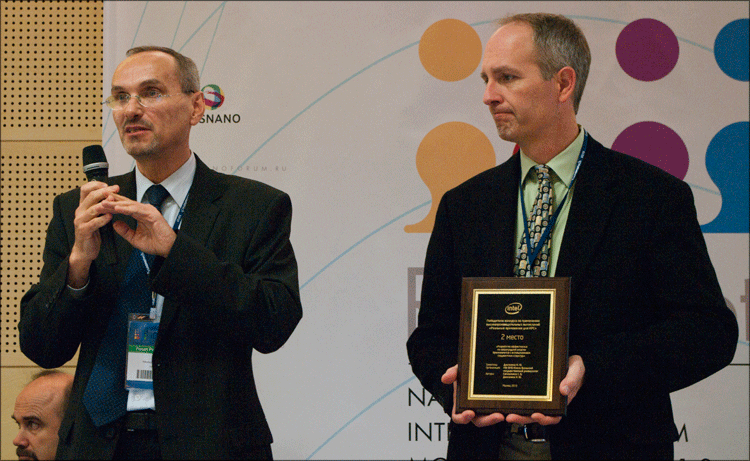
Applicant : graduate student Dolganina Natalya Yurevna from GOU VPO South Ural State University
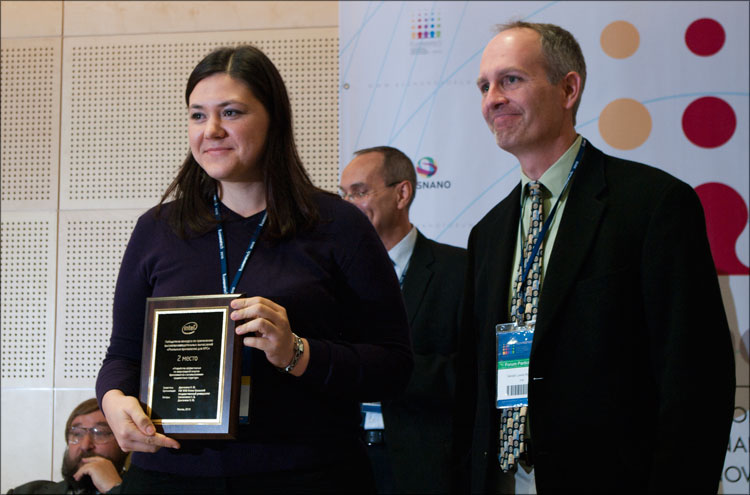
Prize : 125 000 rubles
It is worth noting that this project has not existed for the first year and has long gone beyond the scope of modeling - these rather unique body armor have already become a commercial product and are actively used by domestic special services.
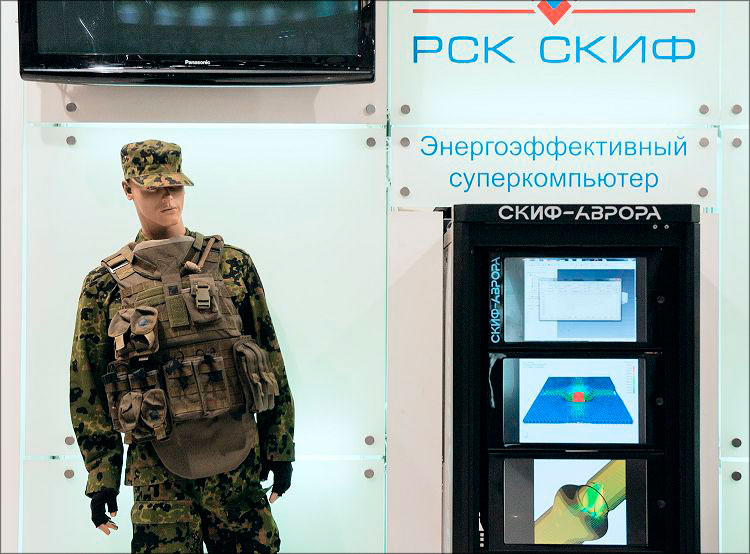
3rd place was divided between 2 projects:
"UGENE - the unified HPC environment for molecular biologists"
Applicant : Engineer Okonechnikov Konstantin Vyacheslavovich
Prize : 62 500 rubles

"High-performance computing in bioengineering technologies for improving the thermal stability of enzymes"
Applicant : Ph.D. Teplukhin Alexander Valentinovich from the Institute of Mathematical Problems of Biology RAS
Prize : 62 500 rubles
The author of the “Best Student Work” was Vladimir Sergeyevich Chashchin, a 1st year graduate student at NRNU MEPhI. For the project “Virtual Design of an Optical Chemosensor Based on a Dye Adsorbed on a Silica Gel Nanoparticle Surface,” he was presented with a distinguished laptop based on an Intel Core i7 processor. Another five finalists got Intel software licenses for high-performance computing - Intel Cluster Toolkit Compiler Edition 3.2.
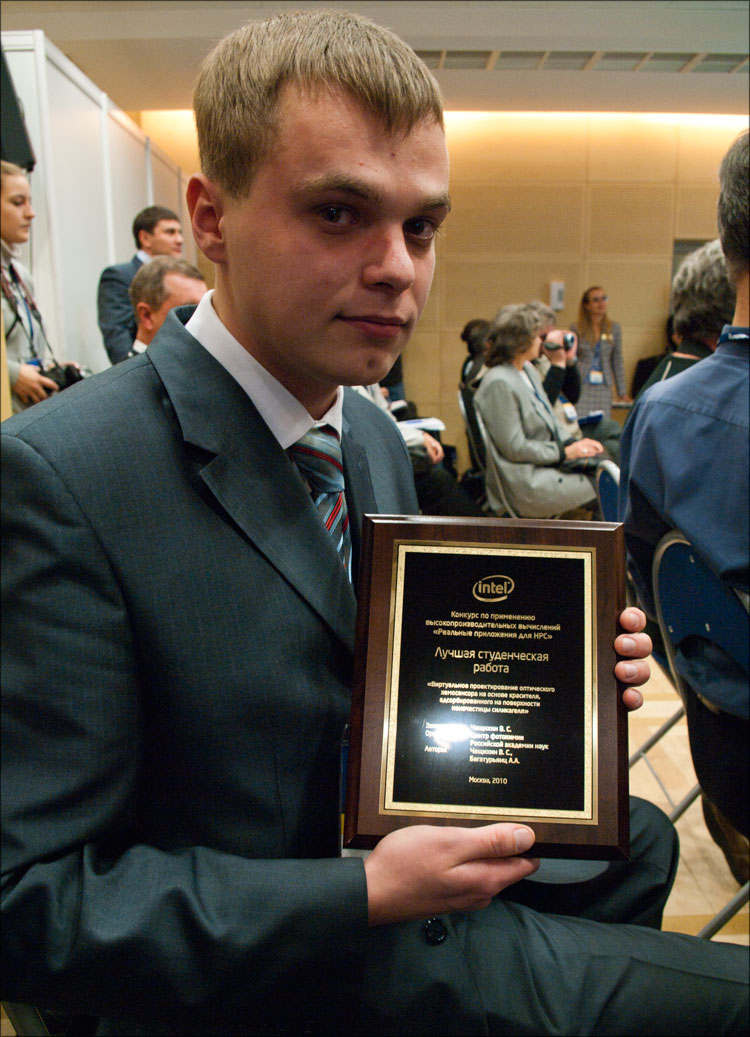
“ It seems that high-performance computing is indeed becoming an important area of Russian scientific specialization. The next step is to expand the use of high-performance computing in the industry ”- Kamil Isaev , general director for research and development of Intel in Russia.
In the nomination "The best work in the field of nanotechnology and nanoindustry" was the project " Supercomputers in the problems of predicting the properties of colored proteins "
Applicant : dfm.n. Bella Lyudvigovna Grigorenko from the Chemical Faculty of Moscow State University M.V.Lomonosova
Prize : 250,000 rubles
The competition initiative was also supported by the Supercomputer Program of the Union State of Belarus and Russia “SKIF-GRID” and the Supercomputer Consortium of Russian Universities. They presented a number of special prizes:
"The use of high-performance computing for modeling small-scale structures in the gas subsystems of spiral galaxies"
Applicant : graduate student Sergey A. Khoperskov from Volgograd State University
Prize : 100,000 rubles from SKIF-GRID
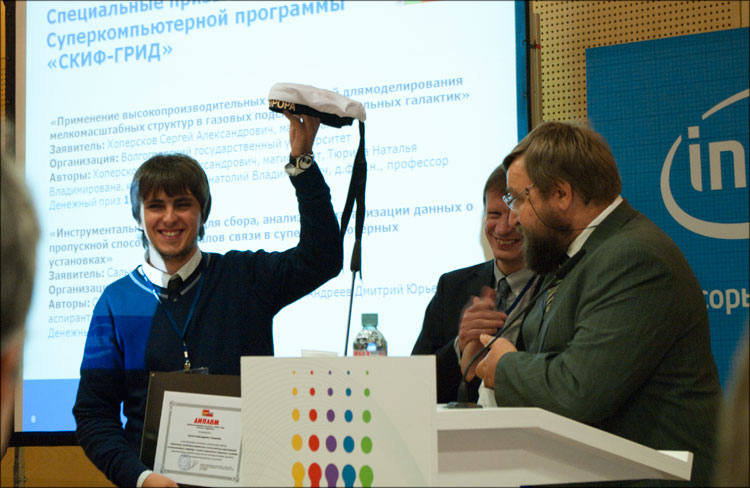
"Instrumental system for collecting, analyzing and visualizing data on the capacity of communication channels in supercomputer installations"
Applicant : Ph.D. Alexey Nikolayevich Salnikov from the Faculty of the VMK of Moscow State University M.V.Lomonosova
Prize : 100,000 rubles from SKIF-GRID
"Investigation of the mechanism of hydrolysis of organophosphorus compounds modified by human butyrylcholinesterase"
Applicant : Lushchekina Sofia Vladimirovna from the Institute of Biochemical Physics. N.M. Emanuel RAS
Prize : 1,000,000 processor hours of work onSkyNet supercomputers of the consortium
“Supercomputers in problems of predicting the properties of colored proteins”
Applicant : dfm.n. Bella Lyudvigovna Grigorenko from the Chemical Faculty of Moscow State University M.V.Lomonosova
Prize : 250,000 processor hours of work on the consortium's supercomputers
"High-performance computing in problems of protein engineering and biopharmaceutics"
Applicant : Ph.D. Stroganov Oleg Valentinovich
Prize : 250,000 processor hours of work on the consortium's supercomputers
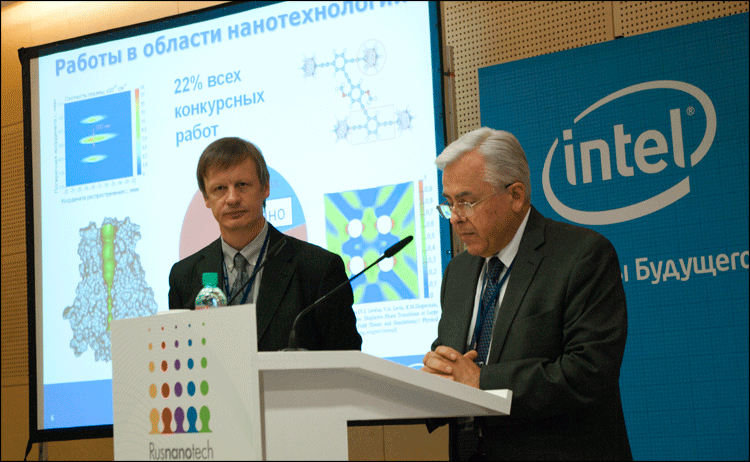
“ Holding such large-scale competitions is extremely important both to support the development of world-class basic and applied research, and to establish a system of supercomputer education, ” said the rector of Moscow State University. Lomonosov, academician V.A. The gardener . And here you can’t argue - who knows, what if I really happened to attend this event together with the great scientists of the future, whose developments the whole world will talk about? ;)
After the official solemn part, everyone went to the exhibition itself, in particular, to the Intel stand - without exaggeration, it was the brightest, largest and most noticeable.

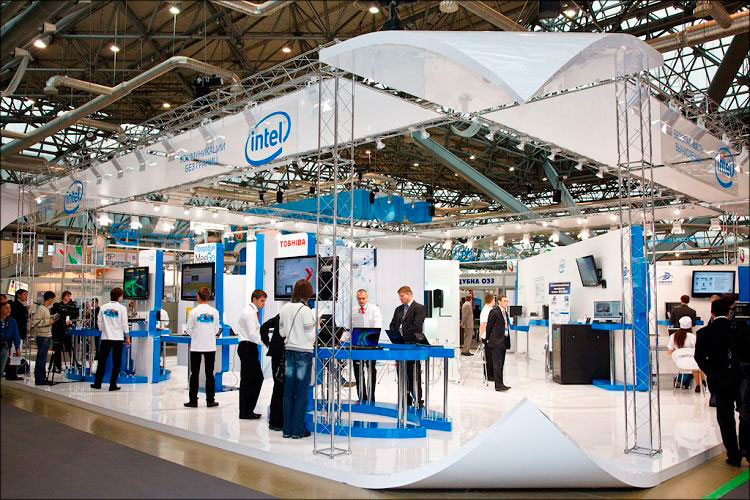
On the presented stands, there were various processors (for mobile, desktop and server solutions), SSD disks, Intel Wireless Display settings, various partner devices based on MeeGo - MID, tablets and netbooks.
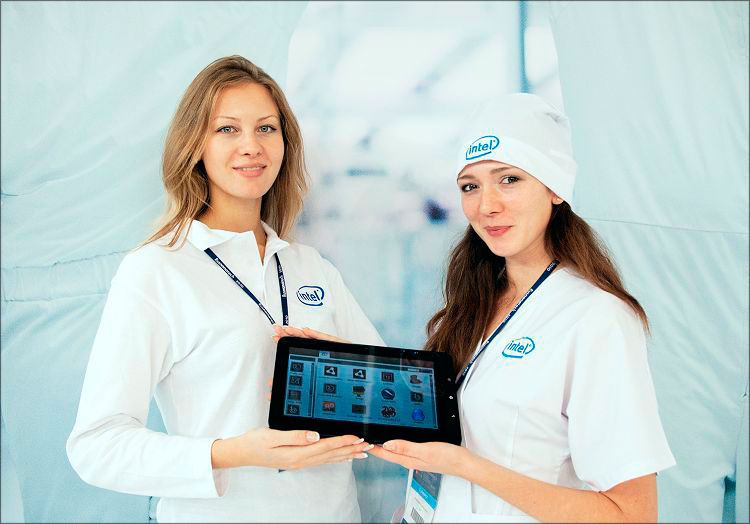


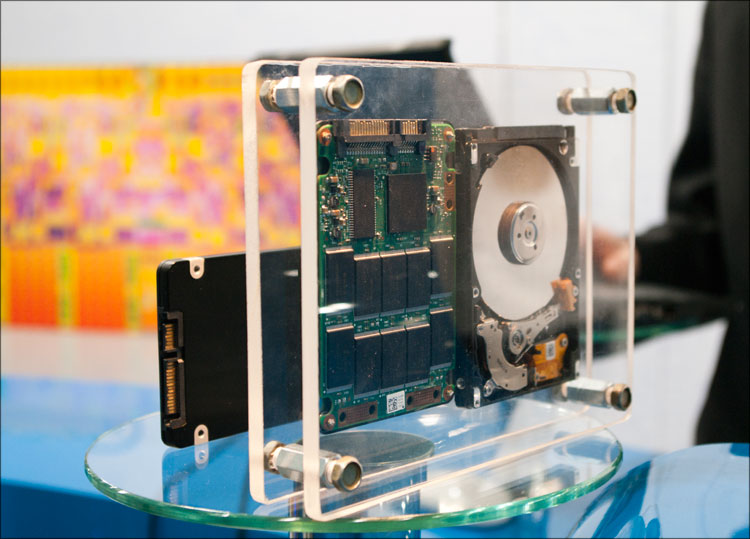


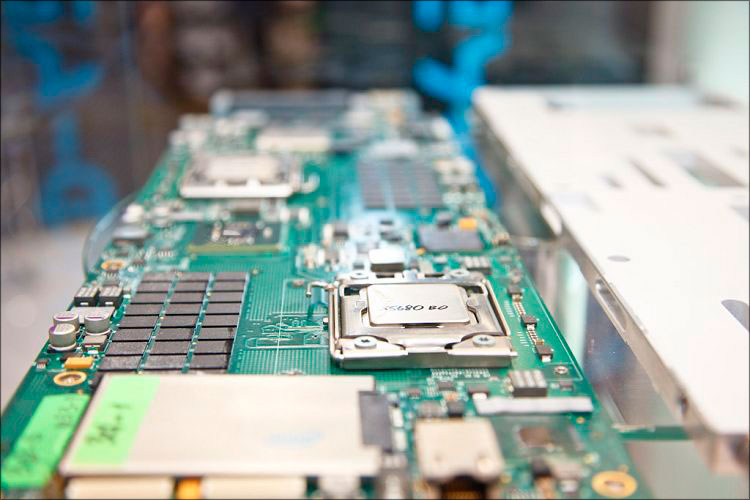
The partner sections on the Intel stand also looked great - DEPO represented the face recognition system, and Aquarius (pictured) - the Classmate PC school netbooks of their own assembly and various peripheral options for them:
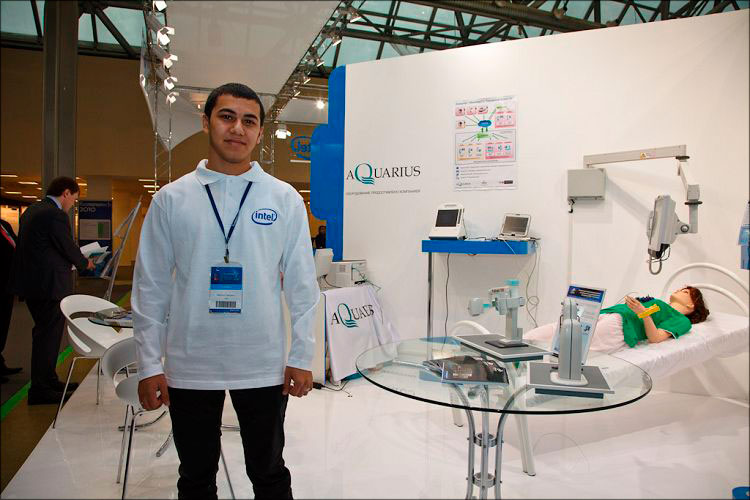
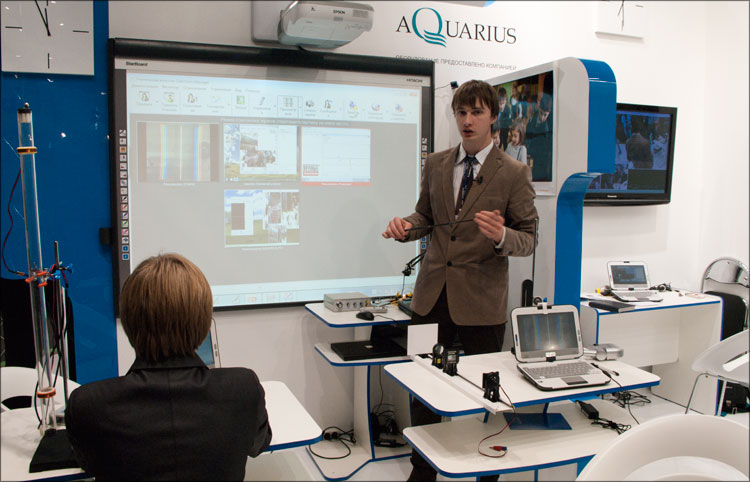
Of course, the exhibition booth was not limited to the Intel company stand - the scale of events at the Expocenter always provide an opportunity to find something interesting. But, unfortunately, I had neither the time nor the opportunity to see all these lasers-powders — some platelets and read about them. If you want, here are a couple of photos that I took while walking with a quick step through the exhibition - I can’t comment on it, so we can be guessing in the comments) Clickable:

























Although something remembered. Here is a photograph of the surface of a 10-kopeck coin taken with an expensive microscope:
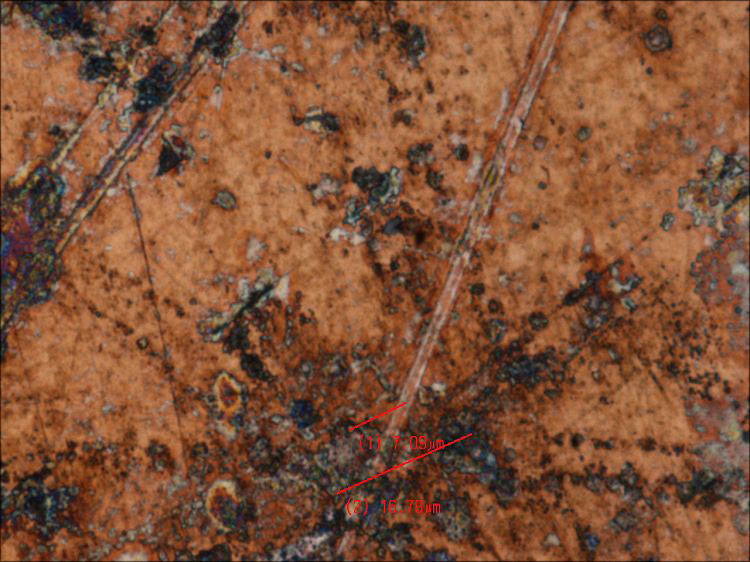
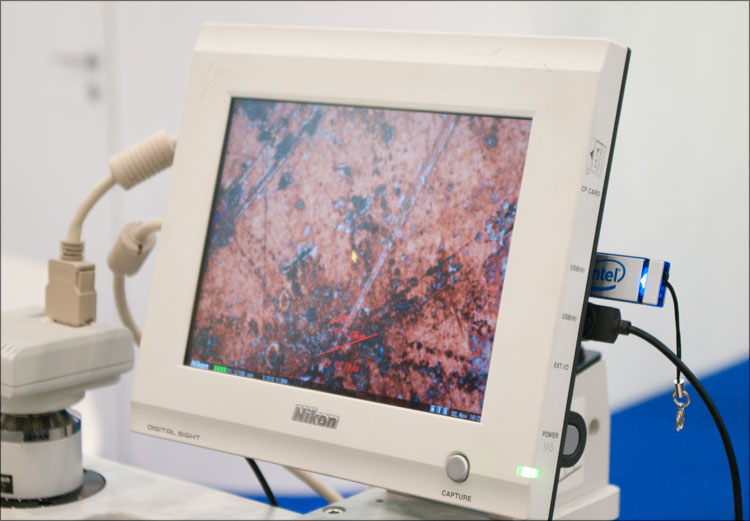
One of the days of the exhibition with the help of this device one could look behind the female processor on the processor without a heat dissipating lid. If you believe the girl from the stand, the microscope is able to automatically measure and analyze electronic chips of a similar level, after which it is possible to construct an appropriate scheme in a CAD application.
I forgot to say about one important point. At the exhibition, Intel presented an interesting stand " From Sand to Processor ", which tomorrow (November 9) will move to the Moscow Polytechnic Museum.
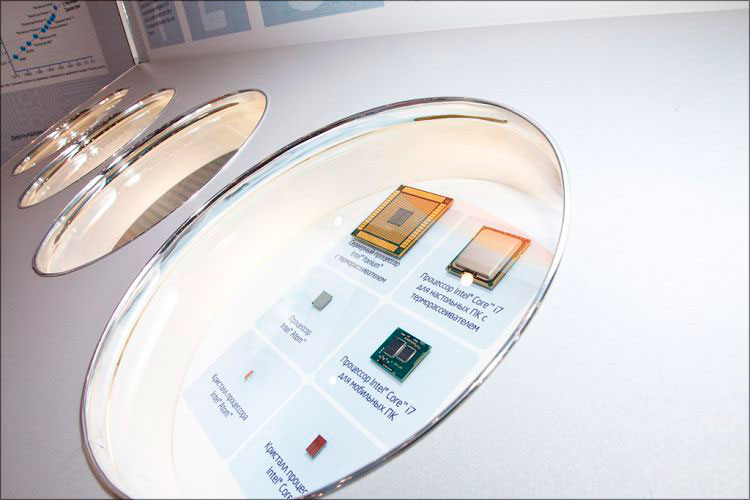
At the opening of the booth, Nikolay Suetin (Intel Projects Development Manager) will tell you about the technology for creating processors, the main problems in the modern semiconductor industry and what awaits it in the future; Also in the program is a short film about the modern Intel factory. New Square 3/4, entrance number 9 - come by 19:00, see you & talk! :)

Two more lectures will be held a bit later - on November 16, Intel Fellow Academician Babayan will speak on the history of microprocessor development, and on November 23, Oleg Semenov, head of the Russian Intel Labs, will give another lecture.
Successes!

Some interesting under the cut.
The purpose of this competition is to identify the best work in using the capabilities of supercomputers, popularize supercomputers and clusters, as well as demonstrate the possibility of practical application of high-performance computing for the needs of various branches of science and industry; and, of course, the support of young scientists seeking to realize themselves through innovation. Under the motto “The Impossible became possible ”, 82 as many works were submitted (which is 2 times more than last year) for the competition, the total prize fund of which amounted to almost one million rubles. The concentration of inquiring minds turned out to be quite expected, the regional variation of the participants is as follows:
')

Participants presented projects on the use of HPC in biology, bioinformatics, geology, three-dimensional gas and hydrodynamics, which, in general, correspond to world trends. Interesting methodological and infrastructural developments related to the creation of tools for the development of various applications were also proposed. The names of most of the projects for me seem somewhat mysterious, despite my technical education) But even more surprised that almost half of the winning works belonged to ... girls! I will not beat around the bush, but will name the winners:

Intel Winners
First place : "Numerical simulation of the interaction of seismic waves with cavernous fractured reservoirs in three-dimensional non-uniform environments of realistic structure"
Applicant : Ph.D. Reshetova Galina V. from the Institute of Computational Mathematics and Mathematical Geophysics of the SB RAS
Prize : 250000 rubles
Second place : "Development of energy-efficient body armor on the basis of gradient energy using gradient structures"

Applicant : graduate student Dolganina Natalya Yurevna from GOU VPO South Ural State University

Prize : 125 000 rubles
It is worth noting that this project has not existed for the first year and has long gone beyond the scope of modeling - these rather unique body armor have already become a commercial product and are actively used by domestic special services.

3rd place was divided between 2 projects:
"UGENE - the unified HPC environment for molecular biologists"
Applicant : Engineer Okonechnikov Konstantin Vyacheslavovich
Prize : 62 500 rubles

"High-performance computing in bioengineering technologies for improving the thermal stability of enzymes"
Applicant : Ph.D. Teplukhin Alexander Valentinovich from the Institute of Mathematical Problems of Biology RAS
Prize : 62 500 rubles
The author of the “Best Student Work” was Vladimir Sergeyevich Chashchin, a 1st year graduate student at NRNU MEPhI. For the project “Virtual Design of an Optical Chemosensor Based on a Dye Adsorbed on a Silica Gel Nanoparticle Surface,” he was presented with a distinguished laptop based on an Intel Core i7 processor. Another five finalists got Intel software licenses for high-performance computing - Intel Cluster Toolkit Compiler Edition 3.2.

“ It seems that high-performance computing is indeed becoming an important area of Russian scientific specialization. The next step is to expand the use of high-performance computing in the industry ”- Kamil Isaev , general director for research and development of Intel in Russia.
Winners from RUSNANO
In the nomination "The best work in the field of nanotechnology and nanoindustry" was the project " Supercomputers in the problems of predicting the properties of colored proteins "
Applicant : dfm.n. Bella Lyudvigovna Grigorenko from the Chemical Faculty of Moscow State University M.V.Lomonosova
Prize : 250,000 rubles
The competition initiative was also supported by the Supercomputer Program of the Union State of Belarus and Russia “SKIF-GRID” and the Supercomputer Consortium of Russian Universities. They presented a number of special prizes:
"The use of high-performance computing for modeling small-scale structures in the gas subsystems of spiral galaxies"
Applicant : graduate student Sergey A. Khoperskov from Volgograd State University
Prize : 100,000 rubles from SKIF-GRID

"Instrumental system for collecting, analyzing and visualizing data on the capacity of communication channels in supercomputer installations"
Applicant : Ph.D. Alexey Nikolayevich Salnikov from the Faculty of the VMK of Moscow State University M.V.Lomonosova
Prize : 100,000 rubles from SKIF-GRID
"Investigation of the mechanism of hydrolysis of organophosphorus compounds modified by human butyrylcholinesterase"
Applicant : Lushchekina Sofia Vladimirovna from the Institute of Biochemical Physics. N.M. Emanuel RAS
Prize : 1,000,000 processor hours of work on
“Supercomputers in problems of predicting the properties of colored proteins”
Applicant : dfm.n. Bella Lyudvigovna Grigorenko from the Chemical Faculty of Moscow State University M.V.Lomonosova
Prize : 250,000 processor hours of work on the consortium's supercomputers
"High-performance computing in problems of protein engineering and biopharmaceutics"
Applicant : Ph.D. Stroganov Oleg Valentinovich
Prize : 250,000 processor hours of work on the consortium's supercomputers

“ Holding such large-scale competitions is extremely important both to support the development of world-class basic and applied research, and to establish a system of supercomputer education, ” said the rector of Moscow State University. Lomonosov, academician V.A. The gardener . And here you can’t argue - who knows, what if I really happened to attend this event together with the great scientists of the future, whose developments the whole world will talk about? ;)
After the official solemn part, everyone went to the exhibition itself, in particular, to the Intel stand - without exaggeration, it was the brightest, largest and most noticeable.


On the presented stands, there were various processors (for mobile, desktop and server solutions), SSD disks, Intel Wireless Display settings, various partner devices based on MeeGo - MID, tablets and netbooks.







The partner sections on the Intel stand also looked great - DEPO represented the face recognition system, and Aquarius (pictured) - the Classmate PC school netbooks of their own assembly and various peripheral options for them:


Of course, the exhibition booth was not limited to the Intel company stand - the scale of events at the Expocenter always provide an opportunity to find something interesting. But, unfortunately, I had neither the time nor the opportunity to see all these lasers-powders — some platelets and read about them. If you want, here are a couple of photos that I took while walking with a quick step through the exhibition - I can’t comment on it, so we can be guessing in the comments) Clickable:

























Although something remembered. Here is a photograph of the surface of a 10-kopeck coin taken with an expensive microscope:


One of the days of the exhibition with the help of this device one could look behind the female processor on the processor without a heat dissipating lid. If you believe the girl from the stand, the microscope is able to automatically measure and analyze electronic chips of a similar level, after which it is possible to construct an appropriate scheme in a CAD application.
I forgot to say about one important point. At the exhibition, Intel presented an interesting stand " From Sand to Processor ", which tomorrow (November 9) will move to the Moscow Polytechnic Museum.

At the opening of the booth, Nikolay Suetin (Intel Projects Development Manager) will tell you about the technology for creating processors, the main problems in the modern semiconductor industry and what awaits it in the future; Also in the program is a short film about the modern Intel factory. New Square 3/4, entrance number 9 - come by 19:00, see you & talk! :)

Two more lectures will be held a bit later - on November 16, Intel Fellow Academician Babayan will speak on the history of microprocessor development, and on November 23, Oleg Semenov, head of the Russian Intel Labs, will give another lecture.
Successes!
Source: https://habr.com/ru/post/107735/
All Articles